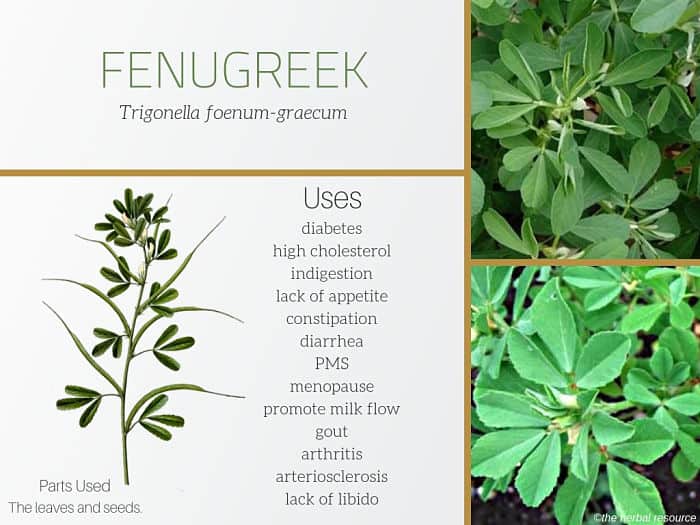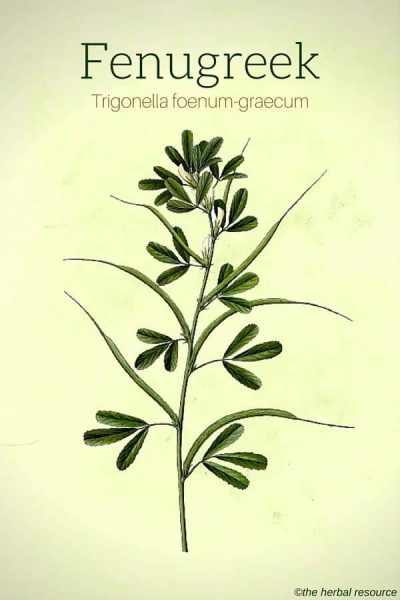Botanical Name: Trigonella foenum-graecum.
The scientific Genus name “Trigonella” comes from the Latin word “trigonus” meaning triangular, referring to the flower’s shape.
The species Latin name “Foenum-graecum” means “Greek hay” due to the plant’s former use in Greece as animal fodder.
Fenugreek is one of the oldest medicinal plants known to man and has been used for hundreds of years both in Eastern and Western herbal medicine.
It has been touted as a panacea, something that could cure all ailments, by many cultures around the world.
What is Fenugreek Used For?
Fenugreek has a long history in traditional herbal medicine and in recent years, it has gained popularity as a medicinal herb for many ailments.
Many of the herb’s therapeutic uses are solely based on traditional and folk medicinal uses, but it does have many promising applications, some of which have been backed up by scientific studies and trials.
People have used fenugreek, e.g., the following conditions:
- diabetes
- high cholesterol
- indigestion
- lack of appetite
- constipation
- diarrhea
- gastritis
- PMS
- menopause
- promote milk flow
- sore throat
- gout
- arthritis
- arteriosclerosis
- lack of libido
- high blood pressure
- hair loss
- cellulitis
- erectile dysfunction (ED)
Fenugreek May Reduce High Cholesterol Level
Recent scientific research has found that fenugreek seeds can help to reduce cholesterol in the blood.
It is the herb’s unique fiber composition and the high content of saponins that are thought to be responsible for both the glucose-lowering and cholesterol-lowering effects. 1
May Help Control Diabetes
In recent years it has gained popularity as a natural treatment for diabetes in adults.
Both clinical and laboratory research have shown that the herb contains many substances that help to lower blood sugar levels and decrease insulin resistance and it seems to benefit both people with type 1 or type 2 diabetes. 23
Fenugreek Can be Useful for Digestive Problems
Fenugreek seeds have been used for loss of appetite and anorexia due to their ability to increase appetite and improve nutrient absorption and digestion.
Fenugreek seeds consist, up to 50%, of mucus-containing fibers that add a protective layer on the intestinal membranes and can give relief from ulcers, heartburn and irritation and inflammation of the stomach and intestine.
The fiber may also help relieve constipation because it softens the bowel contents and at the same time it is considered a useful herbal remedy for diarrhea as the seeds husks absorb water resulting in a bulkier stool.
Fenugreek May Help Improve Lactation During Breastfeeding
Fenugreek seeds contain hormone precursors (phytoestrogens) that are thought to increase milk production in nursing mothers, and the herb is often used traditionally for insufficient lactation.
Several studies have been done to confirm this traditional application.
While few studies have show fenugreek to be effective in increasing the production of breastmilk, others have found it to have hardly any effect in increasing lactation. 45
Also, it has a reputation for enlarging breast tissue and is widely used in natural breast enhancement products.
Fenugreek seeds contain diosgenin, a substance similar to the female sex hormone estrogen, and other plant phytoestrogens which are thought to promote breast growth in women.
Diosgenin is used extensively in the pharmaceutical industry, including in the production of cortisone preparations and oral contraceptives. However, no scientific proof can confirm that fenugreek seeds can enlarge breast tissue and more studies are needed.
It may be useful as an herbal remedy to minimize the symptoms of menopause, and it is thought to be helpful for painful PMS.
May Increase Libido
It has been used through the ages to heighten sexual desire both in men and women and has been used for premature ejaculation and impotence.
The herb lowers blood cholesterol levels, improves blood circulation and can, therefore, increase blood flow to the penis.
May be Beneficial for Respiratory Ailments
Tea made from the seeds has been used for a long time to treat lung diseases such as bronchitis and asthma.
It is also considered a good herbal remedy for a sore throat and coughs. A mucus-like substance found in the seeds has soothing properties by forming a barrier that protects the mucous membranes of the respiratory tract against mechanical and chemical irritation.
External Uses
Fenugreek has been used for skin irritation, such as ulcers, boils, eczema, dandruff, and cellulite.
Some other external traditional applications of the herb have been as a healing agent, to treat infected wounds, and due to its anti-inflammatory properties it has also been used to treat hemorrhoids, gout, rheumatism, muscle pain, treat halitosis and aching joints.
Other Medicinal Uses of Fenugreek Seeds
In modern times, the interest in the herb in the Western world has primarily been because of the alkaloid trigonelline found in the plant, which has been shown to have some potential in the treatment of liver and cervical cancer.
It has been used as a traditional herbal remedy to promote hair growth both in women and men.
In Saudi Arabia, the leaves and seeds are used as a remedy for kidney stones. In one animal study it was noted that when rats were given a dose of fenugreek daily for a month, they had a significant reduction in the amount of calcium that was deposited in the kidneys, which can support this folk medicine usage.
The leaves of fenugreek contain the substance choline, and the seeds are an excellent source of the antioxidant beta-carotene.
Both substances may be helpful for memory loss, Alzheimer’s and slow down the aging process. Additionally, choline can be used to treat arteriosclerosis because of the ability to remove accumulated fat (cholesterol) from the artery’s walls.
The seeds might be effective against roundworms, and they contain some chemicals that have insect repellent properties and can be used as an insecticide.
Active Substances and Constituents
Fenugreek seeds contain 45-60% carbohydrates, 20-30% proteins (high in lysine and tryptophan), 5-10% fatty oil (lipids), pyridine-type alkaloids (predominantly trigonelline, choline, gentianin and carpaine), flavonoids (apigenin, luteolin, orientin, quercetin, vitexin and isovitexin), free amino acids (such as 4-hydroxyisoleucine, arginine, histidine and lysine), saponins.
Fenugreek also contains glycosides that form steroidal sapogenins by hydrolysis (diosgenin, yamogenin, tigogenin, neotigogenin), bitters, coumarins, cholesterol, sitosterol, vitamins A, B1 and C, minerals (including calcium, phosphorus, and iron) and 0.015% of essential oil.
The substance diosgenin, which is also found in wild yam (Dioscorea villosa), is used in the modern pharmaceutical industry to manufacture, e.g., cortisone preparations and oral contraceptives.
Plant Parts Used
The leaves and seeds. The leaves are picked in the summer and used fresh.
The seeds are collected when they are ripe, dried and used in decoctions, pastes, and powders.
The fenugreek seeds are also an important seasoning and are used in many types of curry.
Therapeutic Dosages
Fenugreek seeds can be found in whole or in powder form. They may be eaten raw or cooked or used in salads.
As a tea, two teaspoons of the fenugreek seeds can be used in a cup of boiling water. Allowed to steep for five to ten minutes and then strained. Two to three cups daily are often recommended.
The flavor of the tea can be improved by adding some honey, lemon, aniseed or peppermint.
Potential Side Effects of Fenugreek Seeds
Both the fenugreek leaves and seeds are considered very safe to use. No severe side effects or contraindications have been reported.
Serious interactions with other medications are not known, but it should be used carefully with any medication as it can affect the absorption of other drugs.
The seeds contain water absorbing fibers, so it is advisable to drink plenty of water while using the herb. Fenugreek can change both the color and smell of urine but is not harmful.
Because the herb can stimulate the uterus and has possible estrogenic effects, it should not be used during pregnancy.
Fenugreek may affect the absorption of iron so people who suffer from iron deficiency or have anemia should avoid the herb.
It can cause a topical allergic reaction in some people, especially those who are sensitive to plants in the pea family.
It is always a good idea to consult with a health professional before starting use of any herbs.
Other Common Names
- Greek hay
- Greek hayseed
- Bird’s foot
- Fenigreek
- Greek clover
- Foenugreek
- Sicklefruit fenugreek
- Hu lu ba (Chinese)
- Alholva (Spanish)
- Bockhornsklöver (Swedish)
- Bockshornklee (German)
- Fenugrec (French)
- Methi (Sanskrit/Hindi)
Habitat
Fenugreek is native to the Mediterranean countries and western Asia and is undoubtedly one of the oldest cultivated plants and has for millennia been used both as a medicine and a spice in Egypt, India and the Middle East.
Today fenugreek is widely grown in Argentina, France, India, North Africa, England, and the United States. Nowadays the seeds and fresh leaf shoots come only from cultivated plants.
Description
Fenugreek is an erect annual plant of the Fabaceae or the bean family. It has hairy, green and round stems with few leaf stalks and can grow to be about two feet tall (60 cm). It has trifoliate leaves and blooms white flowers tinged with violet in the early summer.
The flowers develop into long brown pods which contain the fenugreek seeds. The seeds give strong unique aroma, not unlike maple syrup with a hint of celery.
Supporting References
Williamson, Elisabeth M.: Potter’s Herbal Cyclopaedia. Essex, England. Saffron Walden 2003.
Tierra, Lesley: Healing with the Herbs of Life. Berkeley. Crossing Press 2003.
Pamplona-Roger, George D.: Healthy Plants. Madrid, Spain. Editorial Safeliz, S.L. 2006.
Mills, Simon & Kerry Bone: The Essential Guide to Herbal Safety. St. Louis. Elsevier 2005.
Hudson, Tori ND: FENUGREEK – (Trigonella foenum-graecum) An Overview of the Research and Clinical Indications
Lust, John: The Herb Book. New York. Bantam Books 1974.
Duke, James A.: The Green Pharmacy Herbal Handbook. Rodale / Reach 2000.
Atkins, Rosie, et al.: Herbs. The Essential Guide for a Modern World. London, England. Rodale International Ltd. 2006.
Blumenthal, Mark: Herbal Medicine. Expanded Commission E Monographs. Austin, Texas. American Botanical Council 2000.
Bown, Deni: The Royal Horticultural Society New Encyclopedia of Herbs & Their Uses. London, Dorling Kindersley 2002.
Thordur Sturluson
Latest posts by Thordur Sturluson (see all)
- What is the Difference Between Hemp and Marijuana? - June 3, 2019



All this time, My Arabic friends could NOT tell me what these seeds were for…EVEN through I bought them at a Middle Eastern Spice Store…They couldn’t explain either.
I am a chef in Training…Your complete synopsis is invaluable and I thank you very much for your info and insight…..Keith